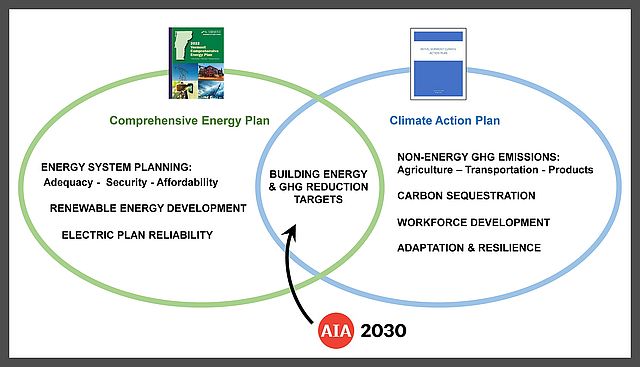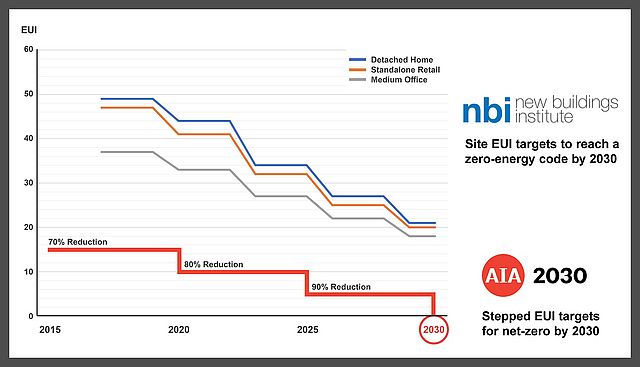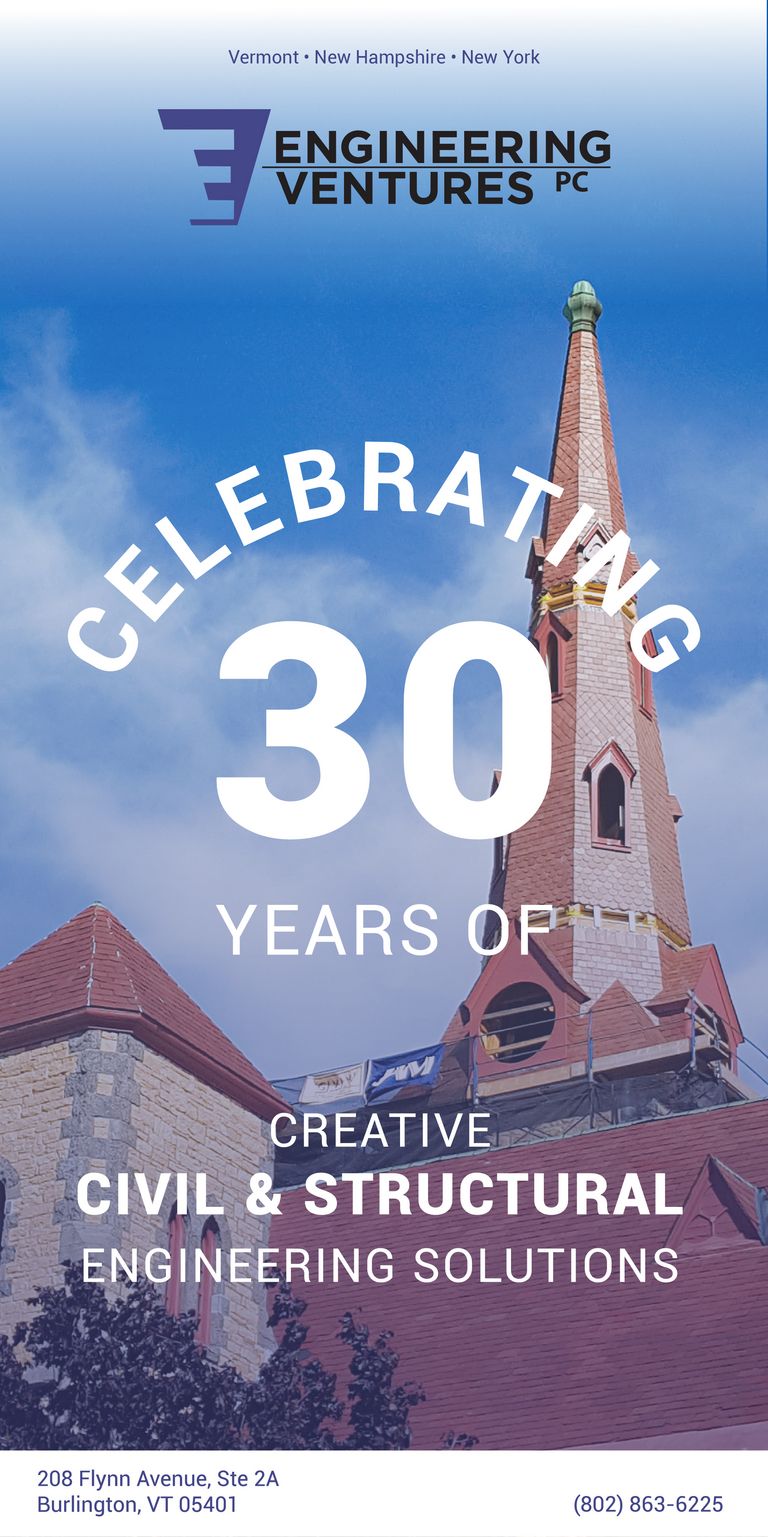How the AIA 2030 Commitment Aligns with Vermont’s Energy Goals
by Matt Bushey, AIA on behalf of the AIAVT COTE Committee
There are multiple policies and initiatives pertaining to energy in Vermont. While these various plans have similar goals – to reduce energy usage and greenhouse gas emissions – they each address different aspects of the fight against climate change. Our work as architects occupies a critical area where many of these plans overlap: building energy.
The AIA 2030 Commitment has targeted a 100% reduction in Energy Use Intensity by the year 2030. To understand how the 2030 Commitment aligns with the state’s energy goals, we looked at a number of these statewide programs and regulations.
The Vermont Climate Action Plan
The Vermont Climate Action Plan is a product of the Global Warming Solutions Act (GWSA), a new law that was enacted in September 2020. The GWSA established a 23-person Climate Council consisting of public officials and private citizens representing stakeholder industries and organizations across the state. The Climate Council is tasked with developing the Vermont Climate Action Plan (CAP) and updating the plan every 4 years.
The first Climate Action Plan was just recently adopted in December 2021, as was required by the new law. The plan is a roadmap for the VT legislature, where it will be used to guide new standards and regulations.
The overarching goal of the Climate Action Plan is to achieve net-zero GHG emissions across all sectors by 2050. This includes building energy use, but also encompasses transportation, agriculture, utilities, and various GHG-emitting products. The CAP also deals with carbon sequestration, workforce development, and climate adaptation and resilience – issues that are certainly important but are not directly applicable to the scope of the AIA 2030 Commitment.
AIAVT’s COTE committee has been following meetings of the Climate Council and is providing feedback for the development of the CAP. The initial version of the Plan emphasizes existing building weatherization and a Clean Heat Standard, but we will advocate for future versions to address new construction in more detail.
The Vermont Comprehensive Energy Plan
The Comprehensive Energy Plan (CEP) has been around much longer. This is a 20-year planning document first required by an act of the Legislature in the 1990s. The first version was issued in 1998 and is updated every 6 years. The most recent plan was released in January 2022.
The CEP is published by the Vermont Department of Public Service (the same department that develops the state energy code) and is an assessment of the supply and demand of all energy sources in Vermont. Like the Climate Action Plan, the CEP is not itself a regulatory document, but it does include recommendations for legislative action.
While the CEP is strictly focused on energy, it does cover all energy sectors, including electric, thermal and transportation. And the CEP deals with all aspects of Vermont’s energy landscape, including system development, adequacy and affordability.
The goals of the CEP are similar to the CAP, with an emissions reduction of 40% below 1990 GHG levels by 2030, and 80% below 1990 GHG levels by 2050. The CEP establishes a pathway for all new buildings to be constructed to net-zero standards by 2030, and for Vermont to obtain 90% of its energy from renewable sources by 2050.
While the long-term goals of these two plans are closely aligned, each one encompasses a different scope of study. Where these two plans overlap is that they both include strategies to reduce building energy usage and set greenhouse gas reduction targets. This is the purview of the AIA 2030 Commitment, which also aligns closely with our state energy codes.
RBES and CBES Building Energy Standards
It is well known that the state energy codes are on a trajectory toward net-zero construction by 2030. The current version of RBES and CBES is heading in that direction, but it is up to each successive version of the code to continue the stepped approach to net-zero. The codes are updated every 3 years, and the Public Service Department is already at work on the next iteration, due in 2023. Public stakeholder meetings are scheduled for April and May to gather input and feedback.
One of the parties advising the state on the development of RBES and CBES is the New Building Institute, a non-profit organization that works to achieve net-zero buildings by 2030. NBI has developed a stepped approach to get to net-zero and is also driving updates to the IECC and ASHRAE 90.1.
Alignment with the AIA 2030 Commitment
The AIA 2030 Commitment relies on the singular metric of EUI to gauge progress toward net-zero construction, while RBES and CBES prescribe specific requirements such as wall R-values and maximum allowed levels of envelope infiltration. But if you look at the long-term goals, it is clear that both are in alignment in their drive toward net-zero by 2030. The targets of the AIA 2030 Commitment are slightly ahead of the state-level energy codes, but architects nationwide are not yet meeting the AIA targets.
This all aligns nicely with the Climate Action Plan and Comprehensive Energy Plans as well. Both are based on a stepped set of targets. The AIA 2030 Commitment set a target of 50% reduction in building EUI by 2005, increasing 10% every 5 years, to hit a 100% reduction in building EUI by the year 2030. The CAP and CEP targets are slightly different, but they encompass a greater scope, including all of Vermont’s energy sources.
The 2030 Commitment provides architects a framework to focus on the one area that is at the center of all these overlapping plans: building energy. AIAVT is continuing to engage with the PSD, the Climate Council, and others, to ensure that all of these efforts remain compatible and complimentary, with the shared goal to reduce GHG emissions and achieve net-zero construction.






